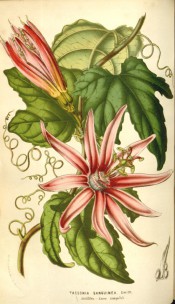Passiflora vitifolia H.B. & K.
Vigorous climber with rusty-downy stems, cordate, 3-lobed, vine-like leaves and scarlet flowers. [Hortus].
Horticultural & Botanical History
‘Passiflora vitifolia, H. B. K., [1817] appears to have been first introduced into Europe from Panama in 1851; but it has never got into general cultivation, probably because it requires tropical treatment to produce its magnificent flowers. At Kew it is cultivated both in the Palm House and the old Lily House, where it flowered in June, 1903. It is certainly one of the most brilliantly coloured species in a genus abounding in gorgeous forms.
It has a wide distribution in tropical America, ranging from Nicaragua to Peru, Guiana and Brazil, and from sea-level in Nicaragua to 3,000 feet in Colombia, where Lehmann (n. 1268) observed stems forty feet long. In the Kew Herbarium there are dried specimens of flowers of this species from Panama (Fendler, 118) fully six inches across.’ [BM t.7936/1904].
‘Passiflora vitifolia: This is a very fine species, but not so free-flowering as some, which may account for its being less frequently met with than the brilliancy of its flowers would justify. It is an old inhabitant of our gardens which has apparently been lost to cultivation more than once, and re-introduced under a new name; thus it is the P. sanguinea of some, the Tacsonia Buchanani of others, while at the hands of the botanists it has received several synonyms. Those who desire full information as to the botany and history of the species, will find full particulars in Dr. Masters’ monograph of these plants in the Flora Brasiliensis. The plant is a native of the Amazon district of New Granada and Central America, and varies considerably, whence the multiplicity of names given to it. Under cultivation its chief enemy is red-spider, which may easily be kept down by occasional syringing with weak tobacco-water or an infusion of Quassia chips. [GC p.212/1890].
It is also figured as Passiflora sanguinea Sm. in Flore des Serres. [FS f.803/1852].
History at Camden Park
Desideratum to Loddiges’ nursery on 6th January 1845 [MP A2933-2, p.28]. I have found no further records and it may never have been grown at Camden. It was described by Smith in Rees’s Cyclopaedia under the name of Passiflora sanguinea in 1819. It could well have been introduced to horticulture under this name soon after this and well before the date of 1851 given in Curtis’s Botanical Magazine.
Notes
Another possibility is Passiflora sanguinea Colla, a hybrid with scarlet flowers. [PD]. Flore des Serres describes it as a hybrid between Passiflora alata and Passiflora racemosa.
Published Jan 31, 2010 - 04:54 PM | Last updated Jul 29, 2010 - 01:59 PM
| Family | Passifloraceae |
|---|---|
| Category | |
| Region of origin | Tropical America |
| Synonyms |
|
| Common Name | |
| Name in the Camden Park Record |
Passiflora sanguinea |
| Confidence level | medium |


